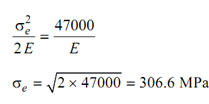Equivalent Stress:
Equivalent stress is a concept helpful in the design of components undergoing a stress field along multiple components of stress. A corresponding stress equivalent to a given state of stress is the value of uniaxial stress that shall produce the similar effect (depending on the theory utilized) as that generated by the given set of stress components.
Example
Assume the state of stress given in Figure (a).
(a) In according to principal stress theory the equivalent stress for this particular case is simply s1, i.e. 300 MPa.
(b) Let us assume principal strain theory.
The principal strain introduced in this case is as follows :
e 1 = 300 /E - ( 0.3 x (200 /E)) = 240/E
This much of strain might be generated in uniaxial tension by a stress of 240 MPa and therefore, the equivalent stress in according to principal strain theory is 240 MPa.
(c) Maximum shear stress tmax = (300 - 200)/2 = 50 MPa .
This could be generated by a uniaxial stress of 100 MPa and therefore equivalent stress according to shear stress theory is just 100 MPa.
(d) Strain energy density, u = 1/2E [3002 + 2002 - 2 x0.3 x 300 x 200]
= 47000 /E ............(i)
If the equivalent uniaxial stress is se, then  -------------- (ii)
-------------- (ii)
i.e.

(e) Distortion energy density
ud = 1/12G [(300 - 200)2 + 3002 + 2002 ] = 70000 / 6G
If equivalent uniaxial stress is se, then

i.e.

Even though we have previous analysed whether the solid is secure or not according to different theories, only by evaluating the equivalent stress, we are capable to get an idea of the margin of security according to each theories.